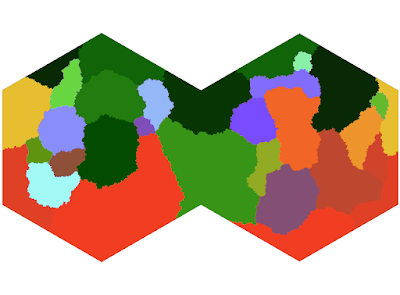I will be going through material sources in an effort to quantify which areas would be most suitable for population generation. To do this I'll rely on the concept of reserves.
On the Higher Path blog [subscription needed], Alexis calls out reserves as:
So let's use the word Reserves to describe wealth as it occurs in the wilderness, and resources to describe wealth as that which the civilised parts of the kingdom actively exploit.
I'll use it in a slightly different way: the level of unexploited resource in the wilderness which may be exploited. Not all wells are equally deep, for instance.
Let us consider the noble auroch. This animal occurs in the following Koppen climates: Aw; As; Am; Csa; Csb; Csc; Cwa; Cwb; Cwc; Cfa; Cfb; Cfc; Dfa; Dfb. As a large mammal, we may also assume it needs at least 1 point of water drainage in a hex to survive (probably a low estimate). This yields the following distribution:
Nothing interesting so far. Let's apply some Perlin noise.
Now, aurochs are not found in every place where they might possibly be. For the sake of illustration, let's do 50% (cattle are pretty ubiquitous, I'd expect this to be on the high side for a reserve).We are left with a number between 0 and 1 detailing the relative level of abundance of the wild reserve of aurochs. What that level is can then be derived separately and scaled. For example, wild cattle generally form herds of about 10 animals, with some instances of up to 184 head/3400 hectares. This is less than a reference per hex: about 0.3 ref/20hex. Obviously, once these herds are domesticated, their size will increase, so the exact relationship between the raw reserve and its resource equivalent will need to be defined.
On the other hand, I could simply tie the 0-1 relative abundance to the maximum developed reference density, which for this resource is 733 ref/20hex (assuming 100% utilization which is obviously a false assumption). Much to think about.
The advantage of using Perlin noise is the fact that it is reproducible given the same inputs: if these are defined for each commodity, then the reserves sort themselves out.







































